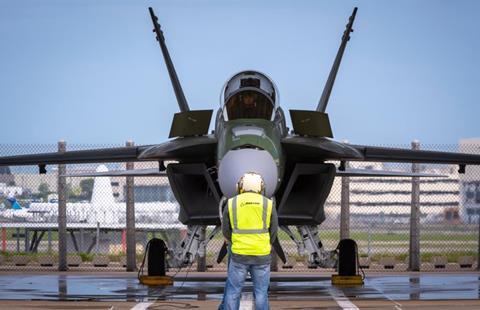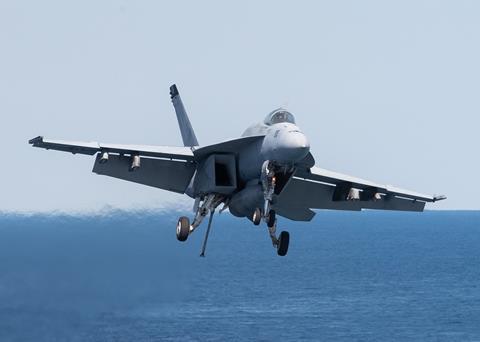The end of the line for Boeing’s F/A-18E/F Super Hornet is fast approaching.
On 23 February, Boeing disclosed plans to cease production of the venerable fourth-generation fighter in late 2025 after delivering the final jet to the US Navy (USN).
Boeing, which produces F/A-18s in St Louis, Missouri, still holds unfilled orders from the USN for 76 F/A-18E/Fs, according to Cirium data.
The airframer says it could extend production to 2027 if a non-US customer places new orders. The Indian navy has been evaluating the F/A-18F for potential use as a carrier-based fighter, with the service also being offered the Dassault Rafale M.

The company is positioning the move as enabling it to focus more attention on developing next-generation military aircraft.
Boeing insists it will remain a force in St Louis, with plans build “three new state-of-the-art facilities” there and to continue hiring.
Its work in St Louis also includes production of several products, including an “all-digital training system”, T-7A Red Hawk jet trainers and the MQ-25 Stingray, an autonomous refuelling aircraft to be deployed from USN aircraft carriers.
Boeing’s St Louis work also includes production of F-15EX Eagle IIs and wing components for its in-development 777X.
“We are planning for our future, and building fighter aircraft is in our DNA,” says Boeing air dominance vice-president and St Louis site leader Steve Nordlund. “As we invest in and develop the next era of capability, we are applying the same innovation and expertise that made the F/A-18 a workhorse for the US Navy and air forces around the world.”

News that the F/A-18’s curtain is closing comes 45 years after long-defunct McDonnell Douglas first flew the twin-engined Hornet in 1978. Boeing acquired McDonnell Douglas in 1997.
The companies have delivered more than 2,000 F/A-18s, including the first-generation version, which entered service in 1983, according to Boeing.
The updated F/A-18E/F Super Hornet made its first flight in 1995, and Boeing delivered the first of another upgrade, the Block II Super Hornet, in 2005. It has also developed a Block III. GE Aerospace supplies the F/A-18’s twin F414 engines.
Customers for the original F/A-18 included the USN, Australia, Canada, Finland, Kuwait, Malaysia, Spain and Switzerland. Of these, Australia and the USN operate Super Hornets, with Kuwait also acquiring the type, while the USN and Australia also operate the EA-18G Growler electronic attack-variant.
Boeing says it will continue supporting F/A-18s, including by rolling out upgrades and through work under a service-life extension programme expected to continue through the mid-2030s. Its current production examples are in the Block III standard.
The F/A-18’s genesis stretches back to the mid-1970s, when the USN began seeking a new air-to-air and air-to-ground fighter to replace jets such as McDonnell Douglas F-4 Phantom IIs and Vought A-7 Corsair IIs, according to the National Naval Aviation Museum.
The USN studied two designs – the YF-16, which became the F-16 Falcon, and the YF-17, which became the original F/A-18.
Corrected: Kuwait also is acquiring the Super Hornet


























